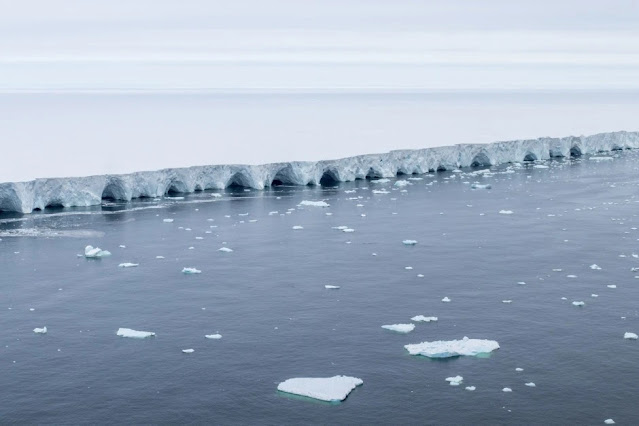West Antarctica's ice sheets are rapidly melting, climate change isn't the only culprit, the heat from the earth's interior also plays a part.

[The Pine Island Glacier in West Antarctica]

There is no question that numerous glaciers are melting amid the "eternal" ice of the Antarctic, contributing to the observed worldwide rise in sea level, as predicted. The melting of the ice sheets is mostly due to two consequences of climate change: rising atmospheric and sea water temperatures. Two of the fastest melting glaciers in the southern polar area now lay on a heat source that has nothing to do with climate change, according to a German-British study team. A very heated earth crust under the Thwaites and Pope glaciers in West Antarctica guarantees that the glaciers' lowest ice layers melt and the glaciers flow extremely fast into the sea as ice streams.
The ice masses of the considerably smaller West Antarctica facing the Pacific, in contrast to the more stable ice of the massive East Antarctica, are continuously in motion. In the last 40 years, the Thwaites and its neighbor, the Pope Glacier, have lost over 5,000 billion tons of ice. This amounts to more than a third of the southern continent's total ice loss over this time period. The meltwater was responsible for roughly 5% of the global sea level increase.
Underneath the ice, there is a thin earth crust.
East and West Antarctica differ not just in terms of ice quantity and drift rates, but also in terms of climate. The two sections of Antarctica are geologically worlds apart. The vast eastern section is an ancient stable continent, similar to the Canadian Shield or Siberia, and is known as a craton. West Antarctica, on the other hand, is a tectonically active, youthful region with frequent earthquakes. Underneath the ice, there are also active volcanoes. This is especially true along the Amundsen Sea's interior. The kilometer-thick ice is situated atop a rift zone where the earth's crust is progressively breaking apart. Similar rift zones may be found over most of East Africa, but they can also be found beneath the Higher Rhine Valley between Basel and Mainz, or beneath the Rio Grande's upper reaches in North America.
The earth's crust is typically just 20 kilometers thick in such rift zones, making it far thinner than under ancient continents like East Antarctica. Furthermore, because the rift zone's sides are progressively sliding apart from each other, the earth's crust is fragile there. Much more geothermal heat may reach the surface from the earth's subsurface through this thin and fragile crust than in stable places. The plentiful geothermal energy is used to produce electricity at many power stations in the Upper Rhine Valley.
Melt water as a lubricant
The geothermal flow in the West Antarctic Rift System has now been estimated by Ricarda Dziadek's research group at the Alfred Wegener Institute in Bremerhaven. The researchers utilize data from a spring 2017 voyage on the research ship "Polarstern" among other sources in their calculations. The region was surveyed in detail for a few weeks from a helicopter using aeromagnetic measuring equipment at the time. The researchers working with Dziadek computed temperatures in the earth's crust and subsequently heat flow on the earth's surface, which is covered in thick ice, using the magnetic measurement results.
The geothermal heat flow in this location averages about 90 milliwatts per square meter, according to Dziadek and her colleagues in the online journal Communication Earth & Environment. This is consistent with measurements taken in other rift zones across the planet. The heat movement under the West Antarctic is, however, far from uniform. Under the Thwaites and Pope glaciers, the study team was able to estimate a very high value of up to 150 milliwatts per square meter.
The glaciers' lowest ice layers are currently melting due to geothermal energy. The meltwater that results works as a lubricant, allowing the ice above to move more swiftly towards the coast. This river is slowed by stable glaciers, glacier tongues floating in the water, and so-called ice shelves in front of the ice masses. However, because climate change is nibbling at the West Antarctic glaciers' ice shelf, their braking effect is significantly weakened. According to AWI researcher Karsten Gohl, one of the study's co-authors, this, along with increasing geothermal energy, results in a massively faster flow of the Thwaites and Pop glaciers into the sea.
© Source : FAZ
